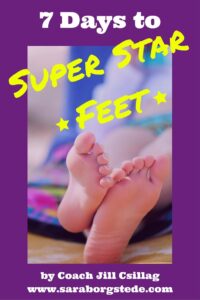- 7 Days to Super Star Feet
- Toe-Nailed It!
- Cotton is Rotton
- Oh My Aching Feet! (Bunions, Corns, and Plantar Warts)
- A Serious Pain in the Foot: Plantar Fasciitis
- Let the Good Feet Roll! Overpronator or Supinator?
- Finding the Right Shoe for YOU

7 Days to Super Star Feet
A Serious Pain in the Foot: Plantar Fasciitis
by Coach Jill Csillag
Plantar Fasciitis.
Oh, how the name of this condition gives me the chills. I suffered from this condition 11 years ago, and still quite vividly recall the pain I felt. Intense pain.
PF has many causes and strikes old and young alike. Oftentimes runners may find themselves dealing with this affliction, but anyone can be a victim to this malady. PF involves pain and inflammation of a thick band of tissue, called the plantar fascia, that runs across the bottom of your foot and connects the heel bone to your toes.
The most telltale symptom of PF is sharp stabbing pain in the heel upon the first steps of the day. As you walk, the pain may lessen, but is likely to return after long periods of standing or getting up from a seated position.
Here are a few of the more common risk factors for developing plantar fasciitis:
- Age. Plantar fasciitis is most common between the ages of 40 and 60.
- Certain types of exercise. Activities that place a lot of stress on your heel and attached tissue — such as long-distance running, ballet dancing and dance aerobics — can contribute to an earlier onset of plantar fasciitis.
- Faulty foot mechanics. Being flat-footed, having a high arch or even having an abnormal pattern of walking can adversely affect the way weight is distributed when you’re standing and put added stress on the plantar fascia.
- Obesity. Excess pounds put extra stress on your plantar fascia.
- Occupations that keep you on your feet. Factory workers, teachers and others who spend most of their work hours walking or standing on hard surfaces can damage their plantar fascia.
If you find yourself suddenly experiencing sharp stabbing pains in the bottom of the foot, especially the heel region, it very well could be you have developed your very own case of plantar fasciitis. Of course, only a doctor can provide a true diagnosis.
What to do now? In my experience I found that wearing proper footwear, especially a good athletic shoe with lots of cushion, lessened my symptoms substantially. I resisted the urge to walk barefoot, I did a lot of stretching to keep the calves and Achilles tendons loose, and also did some self massage by rolling my foot back and forth over a frozen water bottle.
I did ultimately see a podiatrist for the condition, and he gave me 2 rounds of cortisone injected directly into the heel. OUCH. Unfortunately, this did little to nothing to ease my pain, although it does work for some folks.
Advil and Tylenol can be great short-term solutions to lessen the pain of PF as well. Orthotic inserts, either prescription or over the counter, can also speed healing and minimize pain.
There is a handy-dandy invention called the “Strassburg Sock” that you can sleep in at night to keep the plantar fascia muscle extended into the stretched position while you sleep, and it’s been shown to speed healing up to 60% faster. That is, if you can make it all night with your foot contorted into an uncomfortable position. I think I lasted 2 hours with the darn thing on!
PF is a condition that will eventually resolve itself over time, but it could take several months to a year or longer to fully resolve. The crucial piece to the puzzle is to determine what caused the PF to flare in the first place, and do everything in your power to prevent it from returning. This may mean adjusting your footwear (no more high heels), losing weight, keeping shoes on at all times, and stretching your calves on a regular basis. As a preventative measure, I keep a pair of inserts inside my slippers, and put them on as soon as I step out of bed.
Unfortunately there is not one single cause for the dreaded PF, nor is there one single remedy for it either.
Take care of your body, pay attention when things are tight or hurting, and your chances of developing PF will be minimized greatly!
Tomorrow: Are you an Overpronator or a Supinator?
Have a question for Coach Jill? Ask it in the comments below!
Also check out these posts: A Guide to Finding the Best Athletic Footwear for You, Common Foot Injuries and How to Treat Them, 100 lb Weight Loss: How Did You DO It?
Coach Jill’s Favorite Recommended Super Feet Resources:
























Leave a Reply